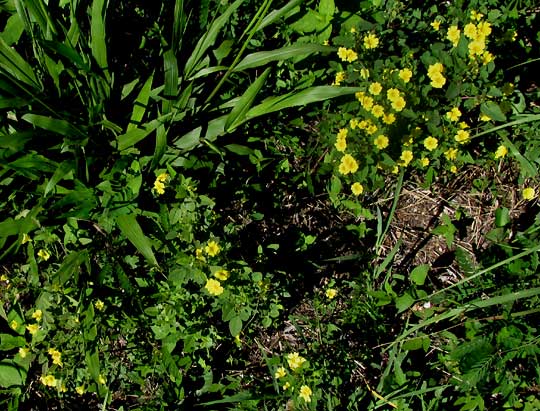Excerpts from Jim Conrad's
Naturalist Newsletter

from the October 18, 2015 Newsletter issued from Hacienda Chichen Resort beside Chichén Itzá Ruins, central Yucatán, MÉXICO
SHRUBBY WOODSORREL
Once or twice a week I hike or bike into Pisté, mostly to buy fruit. Nowadays, at the peak of the rainy season, the weedy roadside is lushly green and woolly, and this week a certain weedy little wildflower was putting on a show with bunches of small, yellow flowers, as shown below:

At first they reminded me of one of those tiny bush marigolds that load themselves with daisy-type flowering heads. However, up close the flowers turned out to be not at all daisy-type, and the leaves were trifoliate, or composed of three leaflets, like clover leaves, seen at the top of this page.
Northern wildflower-lovers know that this combination of small yellow flowers and trifoliate leaves normally indicates a woodsorrel, genus Oxalis. As a child in Kentucky I was taught to call Oxalis species "sourgrasses," though of course they are far from being grasses. It's true, though, that the leaves are so chock-full of oxalic acid that they're very acid to the taste. Often in my salads I've added a few Oxalis leaves just for the taste.
There's something unusual to notice in the above photograph. Notice that the triangular, sharp-pointed sepals below the corollas, and wrapping around unopened flower buds, have violet-purple edges.
The online Flora of Yucatan lists three Oxalis species for the Yucatan Peninsula, and of these only one bears leaflets of the shape shown in the above photo, plus flowers with purple-edged sepals, and that's OXALIS FRUTESCENS, whose only English name I can find is Shrubby Woodsorrel, though the plant doesn't seem so shrubby to me.
Also, all the pictures of Oxalis frutescens flowers I can find on the Internet -- except for the species' photos at the Flora of Yucatan website -- show sepals without the purple margins. Therefore, maybe our Yucatan plants constitute a special regional race or subspecies.
Since Shrubby Woodsorrel thrives in such disrupted habitats as along the road to Pisté, you might expect that the species enjoys a large distribution, and that's the case, occurring in similar spots from the southern US south through most of South America, as well as weedy spots in such places as the Pacific island of New Caladonia.